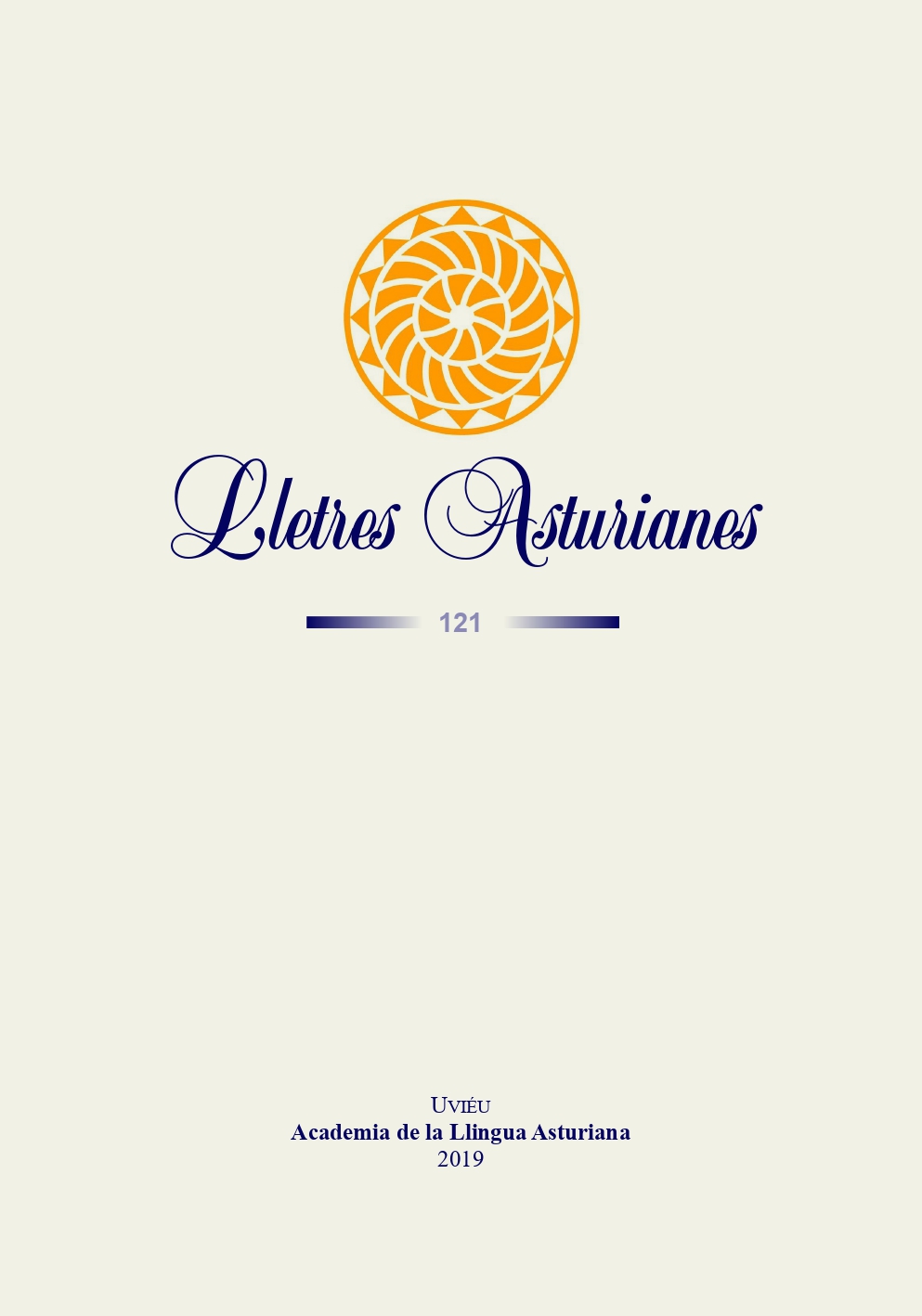Abstract
The Asturian minimizer noun gota has minimal scalar value and it generates pragmatic inferences in negative contexts. Because of that, it is used as a pragmatic strategy to convey the speaker’s attitude towards the utterance, thus providing an additional degree of informativity, which is achieved by inferential mechanisms like explicatures. In Asturian, this minimizer has largely lost its semantic content and its nominal properties, mainly in negative polarity contexts, becoming a quantifier. It can function as a head in partitive and pseudopartitive constructions, and quantify verbal predicates, adjectives and adverbs. A detailed analysis of the syntactic behaviour of MinP leads us to establish three types of minimizers, which might be correlated with the pragmatic value that the minimizer adds to the utterance.
References
ALEXIADOU, Artemis, Liliane HAEGEMAN Y Melita STAVROU (2007): Noun Phrase in the Generative
Perspective. Berlín, Walter de Gruyter.
ALLA = ACADEMIA DE LA LLINGUAASTURIANA (1999): Gramática de la llingua asturiana. Uviéu,
Academia de la Llingua Asturiana [3a ed. 2001].
ANDRÉS DÍAZ, Ramón d’ (1995): «Non y nun», en Lletres Asturianes 57: 49-60.
BOLINGER, Dwight (1972): Degree Words. La Haya, Mouton.
BORER, Hagit (2005): In Name Only. Structuring Sense I. Nueva York, Oxford University Press.
BRUCART, José María (1997): «Concordancia ad sensum y partitividad en español», en Contribuciones
al estudio de la lingüística hispánica. Homenaje al profesor Ramón Trujillo.
Manuel Almeida & Josefa Dorta (eds.). Tenerife, Montesinos: 157-84.
DEMONTE, Violeta & Isabel PÉREZ JIMÉNEZ (2015): «Construcciones partitivas y pseudopartitivas
en español: concordancia híbrida y variación en la interficie sintaxis-semántica», en
Variación y diversidad lingüística. Estudios en busca de una teoría convergente. Esther
Hernández & Pedro Martín Butragueño (eds.). México, El Colegio de México: 15-98.
ESPINALL, Maria Teresa (2008): «La Negació», en Gramàtica del català contemporani. Vol 3.
Joan Solà, Maria-Rosa Lloret, Joan Marcaró & Manuel Pérez Saldanya (eds.). Barcelona,
Empúries: 2729-93.
FLORICIC, Franck (2018): «Observaciones sobre la negación asturiana: comparación con otros
idiomas romances», en Lletres Asturianes 119: 11-35.
GARCÍAVALDÉS, Celsa Carmen (1979): «Algunos aspectos de la negación en asturiano», en Estudios
y trabayos del Seminariu de Llingua Asturiana. Uvieu, Servicio de Publicaciones de
la Universidad de Oviedo: 77-84.
GARZONIO, Jacopo & Cecilia POLETTO (2008): «Minimizers and Quantifiers: A Window on the
Development of Negative Markers», en Studies in Linguistics, Working Papers 2: 59-80.
http://www.diacronia.ro/en/indexing/details/A22678/pdf.
– (2009): «Quantifiers as Negative Markers in Italian Dialects», en University of Venice Working
Papers in Linguistics 19: 81-109.
HORN, Laurence R. (1989): A Natural History of Negation. Standford, CSLI Publications
.
ISRAEL, Michael (2001): «Minimizers, Maximizers, and the Rhetoric of Scalar Reasoning»,
en Journal of Semantics 18 (4): 297-331. https://doi.org/http://doi.org/fh7z5c.
– (2004): «The Pragmatics of Polarity», en The Handbook of Pragmatics. Laurence Horn &
Gergory Ward (eds.). Malden, Oxford, Carlton, Blackwell: 701-723.
LEONETTI, Manuel (1993): «Implicaturas generalizadas y relevancia», en Revista Española de
Lingüística 23 (1): 107-39.
LEONETTI, Manuel & María Victoria ESCANDELLVIDAL (2012): «El significado procedimental:
rutas hacia una idea», en La sabiduría de Mnemósine: Ensayos de historia de la lingüística
ofrecidos a José Francisco Val Álvaro. José Luis Mendívil Giró & M. Carmen Horno
Chéliz (eds.). Zaragoza, Universidad de Zaragoza: 157-68.
PINTO, Clara. (2015). «Para a história da negação: o minimizador homem no português antigo
», en Estudos de Lingüística Galega 7: 109-123.
POSTAL, Paul (2004): «The Structure of One Type of American English Vulgar Minimizer», en
Skeptical Linguistic Essays. Oxford/Nueva York, Oxford University Press: 159-72.
RAE-ASALE = REALACADEMIA ESPAÑOLA YASOCIACIÓN DE ACADEMIAS DE LA LENGUA ESPAÑOLA
(2009): Nueva gramática de la lengua española. Vol I. Madrid, Espasa.
SÁNCHEZ LÓPEZ, Cristina (1999): «La negación», en Gramática descriptiva de la lengua española.
Vol II. Ignacio Bosque & Violeta Demonte (coords.). Madrid, Espasa Calpe: 2561–
SAN-SEGUNDO-CACHERO, Rosabel (2015): «El ‘neutro de materia’ en la morfología nominal del
concejo de L.lena», en Lletres Asturianes. Boletín de l’Academia de la Llingua Asturiana
: 11-37.
– (2016): «Negación enfática metalingüística y estructura informativa: caracterización sintáctico-
pragmática de non» Lletres Asturianes 114: 59-89.
– (2017): «Negación enfática y gramaticalización en asturiano: estructuras con ná» Verba.
Anuario Galego de Filoloxía 47: 1-34.
– (2018): «Entre la cuantificación y la negación: los minimizadores y su papel en la negación
enfática en asturiano», en Sintagma. Revista de Lingüística 30: 39-55.
– (en prensa): «¿Son unidades semiléxicas los sustantivos minimizadores?» en Revista Española
de Lingüística.
– (ms.): «Los sustantivos minimizadores: efectos de la gramaticalización en la interfaz sintaxis-
pragmática».
SAUSSURE, Louis de (2011): «On Some Methodological Issues in the Conceptual/ Procedural
Distinction», en Procedural Meaning: Problems and Perspectives. Victoria Escandell-Vidal,
Manuel Leonetti & Aoife Ahern (eds.). Bingley, Emerald Group: 55-80.
VAN DERWOUDEN, Ton (1994): «Polarity and ‘Illogical Negation.’” In Dynamics, Polarity and
Quantification. Makoto Kanazawa & Christopher Pinon (eds.). Stanford, CA, CSLI: 17-45.
VENDLER, Zeno (1957): «Verbs and Times», en The Philosophical Review 66 (2): 143-160.
http://semantics.uchicago.edu/scalarchange/vendler57.pdf.
VIEJO FERNÁNDEZ, Xulio & Ángel NEIRA (2008): Eslema. Corpus xeneral de la llingua asturiana.
http://eslema.uniovi.es/corpus/busqueda.html [Acceso 06/09/2018]
WILSON, Deirdre (2011): «The Conceptual-Procedural Distinction: Past, Present and Future»,
en Procedural Meaning: Problems and Perspectives. Victoria Escandell-Vidal, Manuel
Leonetti & Aoife Ahern (eds.). Bingley, Emerald Group: 3-32.
WILSON, Deirdre & Dan SPERBER (1993): «Linguistic Form and Relevance», en Lingua 90: 1-

